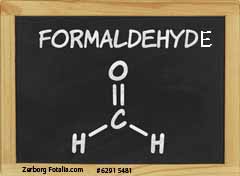 A family from the Bavarian Forest (Germany) has made unpleasant experiences with the longevity of formaldehyde. Two years ago they bought a prefabricated house built in 1975. Initially, the problem did not show up. In the summer was always well ventilated and health problems did not exist. During the winter period dawned residents that something was wrong. The clothes had a strange smell and Ms. Sennerhans plagued a lengthy cold. The analysis of indoor air finally brought certainty: the formaldehyde content in two rooms was above average. Moreover, found the analytical laboratory wood preservatives in house dust.
A family from the Bavarian Forest (Germany) has made unpleasant experiences with the longevity of formaldehyde. Two years ago they bought a prefabricated house built in 1975. Initially, the problem did not show up. In the summer was always well ventilated and health problems did not exist. During the winter period dawned residents that something was wrong. The clothes had a strange smell and Ms. Sennerhans plagued a lengthy cold. The analysis of indoor air finally brought certainty: the formaldehyde content in two rooms was above average. Moreover, found the analytical laboratory wood preservatives in house dust.
Formaldehyde is a colorless gas
The chemical substance with the code CAS 50-00-0 is one of the toxic substances. In animal studies, mutagenicity and sensitizing effects were detected. Formaldehyde is mainly absorbed through the respiratory system and skin. Affected complained of eye and mucous membrane irritation, coughing, difficulty breathing or skin rashes. Chronic exposure may produce general mood disorders such as headaches, memory problems, tiredness, or nervousness.
Diverse sources of formaldehyde indoor
Formaldehyde indoor sources are diverse. Chipboards and wood panels with formaldehyde-based binders are considered as the main cause. They are built in furniture, flooring or paneling. Formaldehyde is partially included in situ foams, polyurethane-based paints, adhesives or sealants. Not only in the living area we meet the chemical: so get wrinkle-free materials their desired properties by adding formaldehyde. Last but not least, while smoking a cigarette escape besides the known pollutants, constituents of the colorless gas.
Evaluation standards for formaldehyde
The Federal Environment Agency of Germany (UBA) has set a guideline value of 0.1 ppm indoor. This value should not be exceeded even under adverse conditions. The World Health Organization (WHO) sets a guideline value of 0.08 ppm or 100 µg/m³. Moreover, there is cause for concern. A guideline value of 0.05 ppm or 60 µg/m³ is the lower limit. The lower guideline is based on literature references. Physical discomfort was reported at concentrations above 0.05 ppm. Experience shows that are air concentrations of formaldehyde in the unloaded rooms in a range of 0.02 to 0.05 ppm. Formaldehyde is detectable even in outdoor air in concentrations up to 15 µg/m³ or 0.01 ppm. Polluters are automobile exhaust and emissions from industrial and domestic heating.
Measures to reduce the formaldehyde content
The most effective measure is the dismantling of the contaminated material. Particle board or insulation should be removed. Sealing the formaldehyde source with a barrier layer is only limited effectiveness. Aluminum foil or barrier coatings are suitable for this method. Building physics effects to be assessed separately.
Another possibility for improving the indoor air is the increased ventilation. About an exclusive window ventilation, the problem can not be eliminated. On installation of a ventilation and air conditioning (HVAC system) is no way around.
